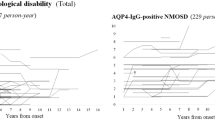Abstract.
Objectives:
To evaluate the clinical characteristics, course and prognosis of Devic’s neuromyelitis optica (DNO), to evaluate the prognostic role of demographic and clinical features, to evaluate the current DNO diagnostic criteria.
Methods:
Demographic, clinical, CSF and MRI data of patients affected by DNO were collected from fifteen Italian MS centres. Inclusion criteria were: 1) two or more acute episodes of neurological dysfunction indicating involvement of the optic nerve and spinal cord, in a simultaneous or subsequent temporal relationship; 2) no evidence of lesions beyond the optic nerve or the spinal cord; 3) brain MRI at onset negative or non-specific for multiple sclerosis (MS) (white matter lesions ≤ 2). Disability was scored by means of Kurtzke’s Expanded Disability Status Scale (EDSS).
Results:
46 patients with relapsing DNO were included, 37 females and 9 males, with mean age at onset of 40.1 ± 16.3 years (range 12–77 years). The follow up duration was 8.8 ± 3.5 years, the mean annualised relapse rate was 1.3 ± 1.2. After 5, 10 and 15 years EDSS 3.0 was reached respectively by 65%, 82 % and 86% of cases, EDSS 6.0 respectively by 42%, 53 % and 69% of cases, EDSS 10 respectively by 8%, 12% and 23% of cases. The probability of reaching EDSS 3 was statistically correlated with age at onset, interval between the first and 2nd attack, and relapse rate. The probability of reaching EDSS 6.0 was correlated with the residual EDSS at onset and to relapse rate.During the follow up, brain white matter lesions appeared in 8 subjects. Spinal cord MRI showed lesions extending across 3 or more segments in 39 subjects, only 1 lesion involving 1 segment in 4 subjects, and was normal in 3 subjects. One or more CSF abnormalities were found at least once in 29/44 patients (65.9 %), the most frequent findings being pleocytosis (38.6 %), oligoclonal bands (34.1 %), high protein level (25 %), and high albumin ratio (20.5 %).
Conclusions:
DNO has a poor prognosis in most cases. Compared with MS, DNO patients have a higher age at onset, females are more frequently affected, the course is more severe. Brain and spinal cord MRI permit the differentiation of DNO from MS. CSF supports the probability of DNO if it shows increased cells and proteins.
Similar content being viewed by others
Author information
Authors and Affiliations
Consortia
Corresponding author
Additional information
* participants in the Italian Devic’s Study Group are listed in the Appendix.
Rights and permissions
About this article
Cite this article
Ghezzi, A., Bergamaschi, R., Martinelli, V. et al. Clinical characteristics, course and prognosis of relapsing Devic’s Neuromyelitis Optica. J Neurol 251, 47–52 (2004). https://doi.org/10.1007/s00415-004-0271-0
Received:
Revised:
Accepted:
Issue Date:
DOI: https://doi.org/10.1007/s00415-004-0271-0




